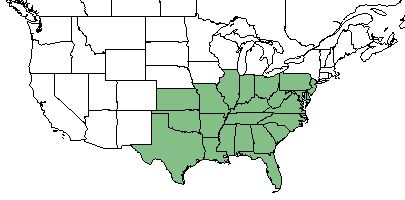Elephantopus carolinianus
Common name: Carolina elephantsfoot [1], leafy elephant's-foot [2]
| Elephantopus carolinianus | |
|---|---|

| |
| Photo by the Atlas of Florida Plants Database | |
| Scientific classification | |
| Kingdom: | Plantae |
| Division: | Magnoliophyta - Flowering plants |
| Class: | Magnoliopsida - Dicots |
| Order: | Asterales |
| Family: | Asteraceae |
| Genus: | Elephantopus |
| Species: | E. carolinianus |
| Binomial name | |
| Elephantopus carolinianus Raeusch. | |

| |
| Natural range of Elephantopus carolinianus from USDA NRCS Plants Database. | |
Contents
Taxonomic Notes
Synonyms: none
Varieties: none
Description
E. carolinianus is a perennial forb/herb of the Asteraceae family native to North America. [1]
Distribution
E. carolinianus can be found along the southeastern United States, from Texas to New Jersey. [1]
Ecology
Habitat
E. carolinianus proliferates in mesic to dry forests and woodlands. [2] Specimens have been collected from roadside depressions, edge of upland woods, rich woods, moist woods, slope of hardwood forest bluffs, hammock, river floodplain, sandy loam, mixed hardwood, sandy river bank, and mesic floodplain. [3]
Phenology
E. carolinianus has been observed to flower in September and October. [4]
Fire ecology
E. carolinianus is not fire resistant, but has a medium fire tolerance. [1]
Conservation and Management
E. carolinianus is listed as endangered by the New Jersey Office of Natural Lands Management Department of Environmental Protection and Energy, and by the Pennsylvania Department of Conservation and Natural Resources. [1]
Cultivation and restoration
Photo Gallery
References and notes
- ↑ 1.0 1.1 1.2 1.3 1.4 USDA Plant Database https://plants.usda.gov/core/profile?symbol=ELCA3
- ↑ 2.0 2.1 Weakley, A. S. (2015). Flora of the Southern and Mid-Atlantic States. Chapel Hill, NC, University of North Carolina Herbarium.
- ↑ URL: http://herbarium.bio.fsu.edu. Last accessed: June 2018. Collectors: Loran C. Anderson, Cecil Slaughter, Richard S. Mitchell, R.Kral, R.K. Godfrey, D.B. Ward, R.R. Smith, G. R. Cooley, R.J. eaton, James D. Ray Jr., O. Lakela, J. Allen, R. Lassiter, J. Lassiter, William B. Fox, S.G> Boyle, Bob Lazor, E.S> Ford, J. M. Kane, C.J. Hansen, C.M. Morton, Peter H. Raven, Tamara Engelhorn Raven, Sidney McDaniel, M.B. Brooks, David Morgan, Robert Norris, John Nelson, Delzie Demaree, Virginia Crouch, James Burkhalter, P. L. Redfearn, D.F. Houck, W.D. Reese, Norlan Henderson, John Beaman, G.G. Hedgecock, K. Smith, W.M. Longnecker, B.C. Tharp, J.J. Brady, Fred A. Berkely. States and counties: Florida ( Wakulla, Leon, Volusia, Jackson, Gadsden, Alachua, Gadsden, Liberty, Hernando, Washington, Citrus, Martin, Bay, Dixie, Calhoun, Holmes, Gulf) Georgia (Baker, Grady, Upson, Thomas) Texas (Gonzales, Dallas, Anderson, Cherokee) Tennessee (Blount) North Carolina (McDowell, Chatam) Alabama (Lee, Escambia, Perry, Choctaw) Missouri (Jefferson, Wright, Franklin, Dade) Kentucky (Powell) Mississippi (Jones, Hinds, Yazoo) Louisiana (Lafayette)
- ↑ Nelson, G. PanFlora: Plant data for the eastern United States with emphasis on the Southeastern Coastal Plains, Florida, and the Florida Panhandle. www.gilnelson.com/PanFlora/ Accessed: 21 MAY 2018